Yearn for inspiration? Discover how Jesus' transformative encounters with individuals in the Bible can illuminate your own journey.
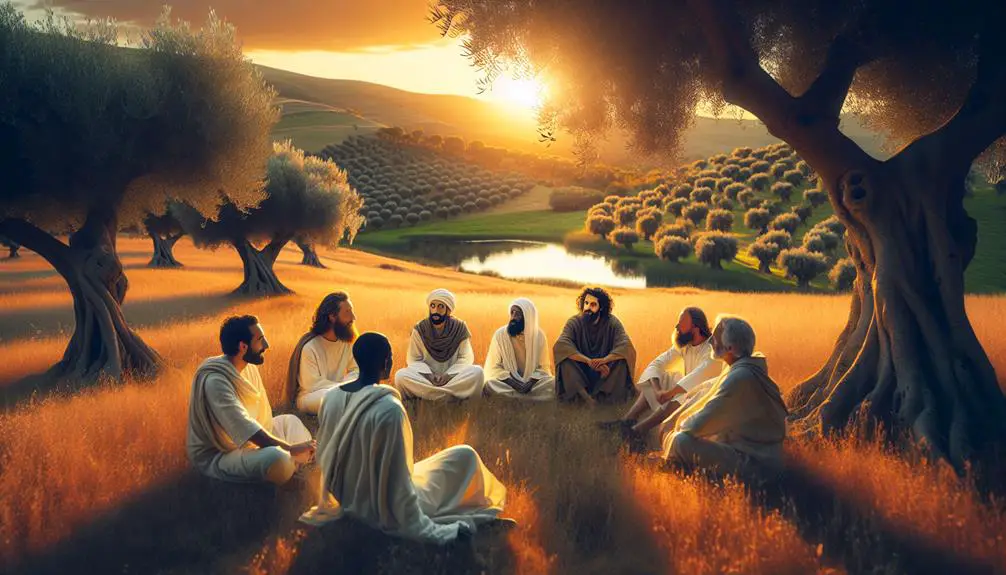
Jesus Encounters With Individuals in the Bible
As you walk through the pages of the Bible, it's like stepping into a gallery where each encounter Jesus had with individuals paints a vivid picture of grace, transformation, and wisdom.
Whether it's a conversation with the Samaritan woman at the well, offering forgiveness to the woman caught in adultery, or restoring sight to Blind Bartimaeus, these stories invite you to explore the depths of Jesus' compassion and the power of personal transformation.
You'll find yourself on the edge of your seat, eager to uncover the layers of meaning behind each encounter and how they might illuminate your own path.
Key Takeaways
- Jesus' interactions often challenged societal norms and invited individuals towards transformation and redemption.
- Encounters with Jesus underscore the power of faith and belief, leading to miracles and profound personal changes.
- Jesus emphasized compassion and forgiveness, encouraging self-reflection and empathy in dealing with others.
- His engagements reveal a ministry focused on inclusivity, breaking down barriers, and offering salvation to all, regardless of status or past.
The Samaritan Woman at the Well
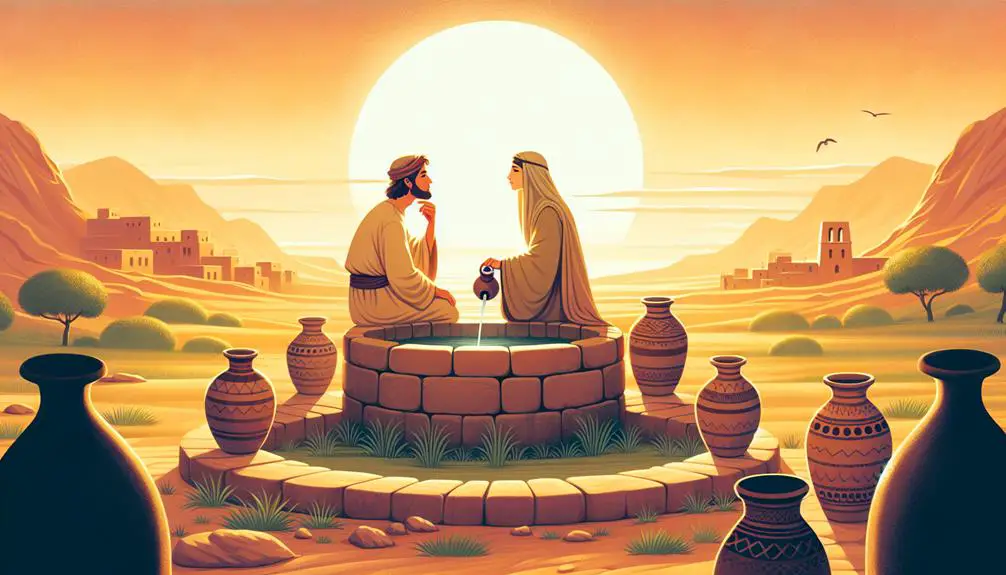
Analyzing the encounter between Jesus and the Samaritan woman at the well reveals deep theological insights and cultural tensions present in the biblical narrative. You'll notice that this interaction isn't just a casual conversation; it's a convergence of cultural barriers and profound spiritual teachings. Jesus, a Jew, engaging with a Samaritan woman not only breaks social norms but also challenges the prevailing prejudices of the time. The Jews and Samaritans had a long history of mutual disdain, making this encounter highly significant.
Moreover, Jesus's offer of 'living water' to the woman introduces a transformative spiritual metaphor. This living water represents eternal life and spiritual satisfaction, contrasting sharply with the physical water she came to draw from the well. Jesus uses this moment to teach about the true worship of God, which transcends geographical and cultural boundaries, emphasizing that it's 'spirit and truth' that matter.
This story, rich in theological depth, underscores the inclusivity of Jesus's ministry and the breaking down of barriers. It highlights how Jesus reaches out across societal divides, offering spiritual nourishment to all, regardless of their cultural or social standing.
Zacchaeus, the Tax Collector
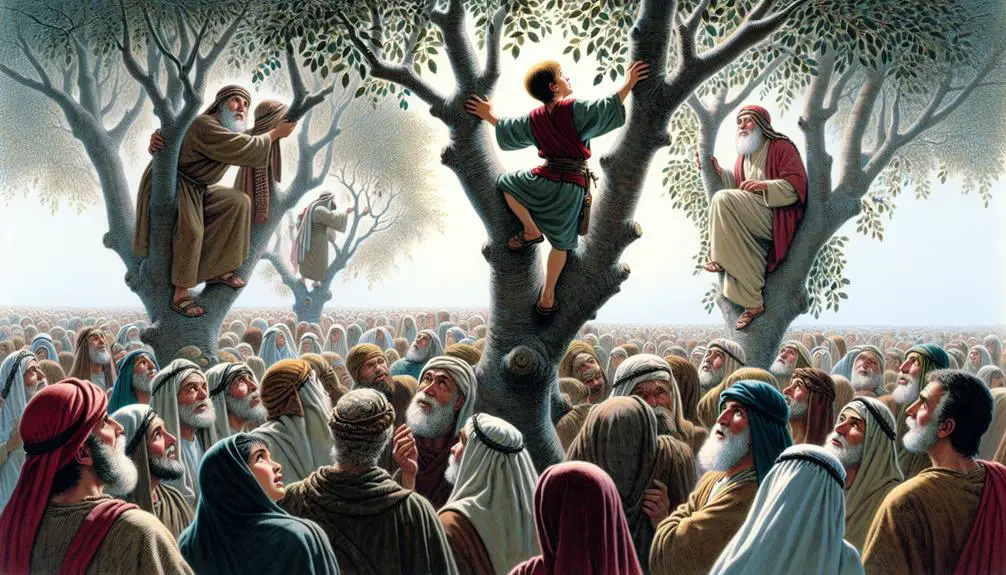
You'll find Zacchaeus' narrative compelling, as it encapsulates a profound transformation journey marked by his initial act of climbing a sycamore tree to catch a glimpse of Jesus. This act, seemingly simple, symbolizes a significant spiritual pursuit and desperation for change.
Furthermore, Jesus' radical invitation to Zacchaeus not only challenges societal norms but also emphasizes the inclusive nature of grace, inviting scrutiny into the dynamics of redemption and acceptance.
Zacchaeus' Transformation Journey
In the biblical narrative, Zacchaeus' transformation journey epitomizes the profound impact of personal encounters with Jesus on individuals entrenched in societal and personal moral dilemmas. Zacchaeus, a tax collector, navigated the complexities of tax collector ethics and societal exclusion before his pivotal encounter with Jesus.
- Tax collector ethics often led to societal distrust and exclusion.
- Societal exclusion amplified personal and moral dilemmas.
- Transformation begins with a willingness to confront one's ethical and societal challenges.
- Genuine encounters with Jesus ignite profound personal change.
- Zacchaeus' journey underscores the possibility of redemption and societal reintegration.
Analyzing Zacchaeus' story reveals the transformative power of divine encounters, showcasing a path from moral and societal isolation to redemption and acceptance, illustrating the impact of Jesus' teachings on individual lives.
Climbing the Sycamore Tree
Zacchaeus' decision to climb the sycamore tree marks a pivotal moment in his quest for redemption, symbolizing his urgent desire to see and be transformed by Jesus. This act of tree climbing transcends mere physical elevation; it represents a profound breach of social barriers, challenging the norms of his status as a tax collector.
Zacchaeus, marginalized by his profession and ostracized by his community, resorts to an unconventional method to seek a transformative encounter. His ascent into the sycamore tree is emblematic of his willingness to rise above societal expectations and prejudices. It underscores the lengths to which individuals might go to overcome obstacles for spiritual fulfillment.
In this narrative, tree climbing emerges not just as a physical act, but as a metaphorical leap towards salvation and social transcendence.
Jesus' Radical Invitation
Upon recognizing Zacchaeus perched among the branches of a sycamore tree, Jesus extended an invitation that shattered conventional expectations, inviting him to descend and share a meal, thereby signifying a moment of profound social and spiritual inclusion.
- Radical acceptance: Jesus' gesture towards Zacchaeus, a tax collector widely despised by society, epitomizes the essence of radical acceptance.
- Inclusive love: This act was a tangible demonstration of Jesus' inclusive love, disregarding societal norms and barriers.
- Social restoration: By dining with Zacchaeus, Jesus not only embraced him but also facilitated his social restoration.
- Spiritual transformation: This encounter underscores the transformative power of acceptance and love.
- Breaking barriers: Jesus' approach challenged his followers to transcend traditional prejudices and embrace a more inclusive worldview.
The Healing of Blind Bartimaeus
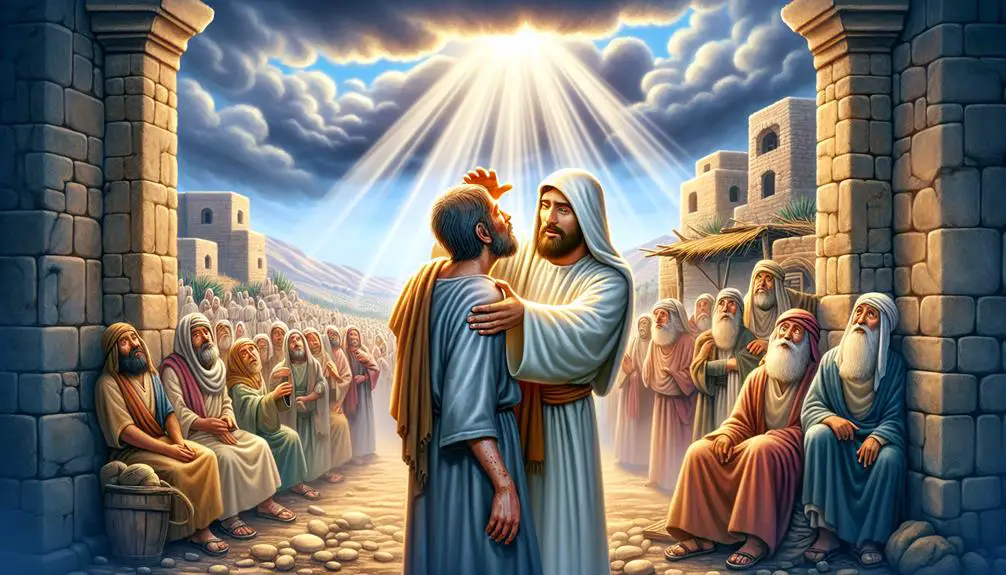
How does the narrative of Blind Bartimaeus in the Bible exemplify Jesus' compassion and power to heal, as seen through the lens of the individual's desperate plea for mercy?
This story, deeply embedded within the New Testament, not only showcases Jesus' miraculous ability to restore sight but also highlights Bartimaeus' unwavering faith amidst societal exclusion.
As a blind man, Bartimaeus lived on the fringes of society, his condition rendering him invisible and marginalized. Yet, his cry for mercy, 'Jesus, Son of David, have mercy on me!' cuts through the noise of the crowd, reaching the ears of Jesus. It's here that Bartimaeus' miraculous faith shines brightly, undeterred by the societal norms that sought to silence him.
Jesus' response to Bartimaeus is telling of His character; rather than ignoring the plea, He stops and calls the blind man to Him. This act alone defies social expectations, as Jesus acknowledges the worth and dignity of those ostracized by society.
Through healing Bartimaeus, Jesus not only restores his physical sight but also reestablishes his social visibility, demonstrating that faith, regardless of societal standing, is recognized and rewarded by Him.
Peter's Denial and Restoration

Denying Jesus thrice before the rooster crowed, Peter's profound moment of failure sets the stage for an intricate exploration of human frailty and divine forgiveness. This episode, deeply embedded in Christian narrative, reveals layers of spiritual and psychological insights through its vivid imagery and symbolic elements. Here's why this account is pivotal:
- The Rooster's Crow: Acts as a powerful auditory symbol, marking the precise moment of Peter's realization and remorse. It's not just a signal of dawn but a clarion call to self-awareness and repentance.
- Charcoal Fire: The setting where Peter denies Jesus mirrors the later scene of his restoration, symbolizing both judgment and redemption. It's a nuanced portrayal of how our points of failure can become the grounds for our healing.
- Human Frailty: Peter's denial underscores the universal susceptibility to fear and failure, inviting readers to empathize with his all-too-human weakness.
- Divine Forgiveness: Jesus' subsequent restoration of Peter highlights the boundless capacity for forgiveness, emphasizing that failure isn't final but a step towards growth.
- Transformation: Peter's journey from denial to being a foundational figure in Christianity exemplifies profound personal transformation, driven by grace and reflection.
This narrative invites you to ponder the complexities of faith, failure, and redemption, emphasizing that moments of weakness can lead to opportunities for profound spiritual renewal.
The Woman Caught in Adultery
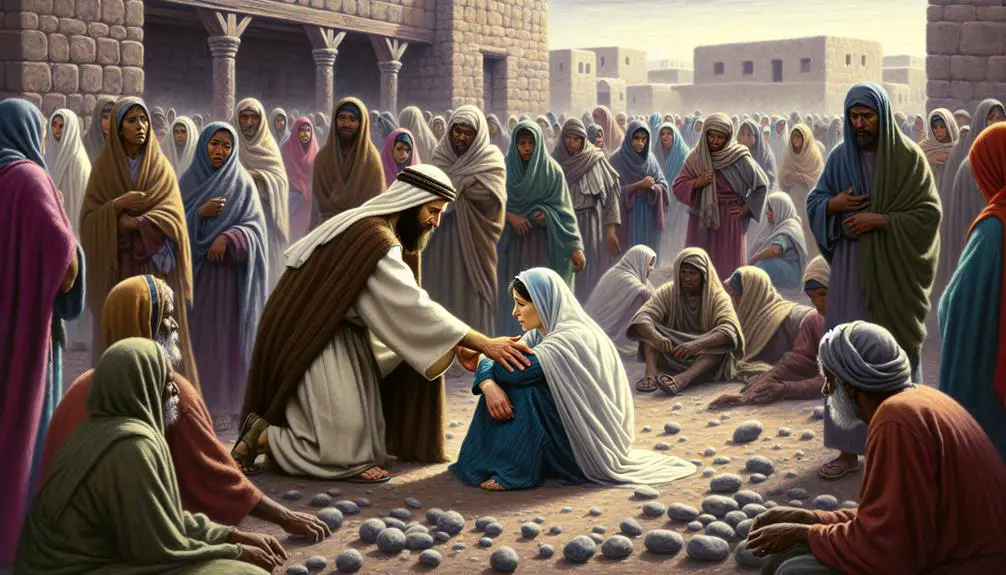
In a pivotal moment of the New Testament, Jesus encounters a woman accused of adultery, offering profound insights into the themes of judgment, mercy, and societal norms. Within this narrative, you'll find a rich tapestry of cultural context that illuminates the stringent societal expectations and the severe consequences for those who deviated.
Jesus' response to the accusers and the woman herself serves as a powerful counter-narrative to the prevailing attitudes of the time.
He challenges the crowd's eagerness to condemn, highlighting the universal human tendency towards hypocrisy. By stating, 'Let him who's without sin among you be the first to throw a stone at her,' Jesus underscores the importance of self-reflection before judging others. This moment isn't just a critique of societal norms but also introduces a radical form of forgiveness symbolism. Jesus embodies the concept of mercy, offering the woman a chance for redemption rather than punishment.
This encounter goes beyond the specifics of the event, suggesting a broader application of compassion and understanding in dealing with the flaws of others. It pushes you to ponder on the transformative power of empathy in a judgmental world, making it a cornerstone example of Jesus' teachings on forgiveness and the reevaluation of societal norms.
The Raising of Lazarus
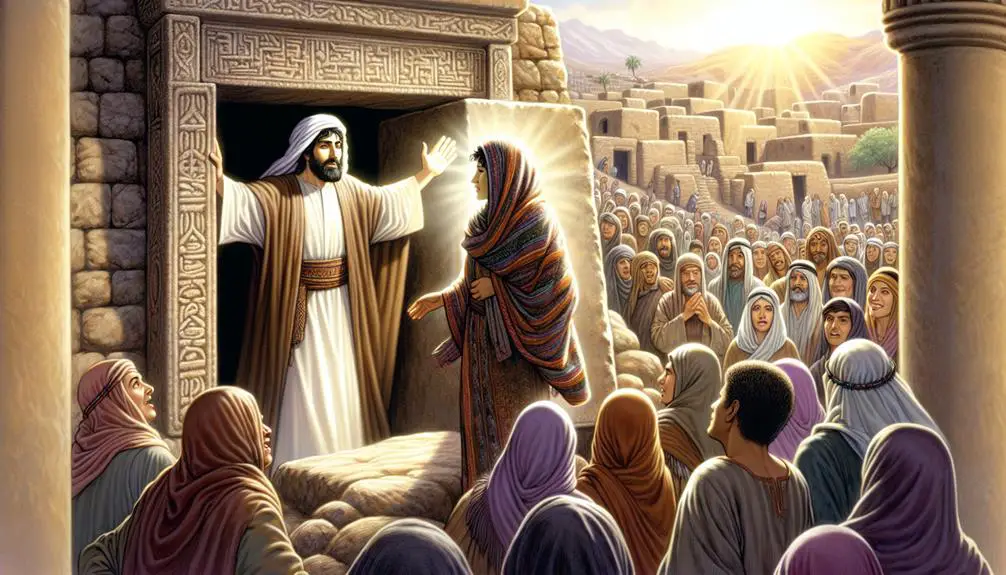
Shifting our focus to another profound moment, we examine the Raising of Lazarus, where Jesus' demonstration of power and compassion intertwines, offering deep insights into the themes of life, death, and faith. This narrative isn't just a miraculous event; it serves as a pivotal teaching moment about the power of belief and the reality of resurrection. Through this encounter, you're invited to delve into a story rich with emotion, faith, and revelation.
- Mourning process: The community's grief highlights the human experience of loss and the longing for hope amidst despair.
- Martha's faith: Despite her grief, Martha expresses a profound belief in Jesus' power, hinting at the depth of her relationship and understanding of His nature.
- Jesus' empathy: His emotional response to Lazarus' death showcases His compassion, challenging notions of divinity detached from human suffering.
- Commanding life: Jesus' authoritative call for Lazarus to come out underlines His dominion over life and death, emphasizing the theme of resurrection.
- Community's response: The varied reactions from the onlookers, ranging from belief to skepticism, mirror the contemporary response to miracles and divine intervention.
Analyzing the Raising of Lazarus, you're confronted with a multifaceted exploration of faith, the human condition, and the promise of eternal life, encapsulated in a story of loss, hope, and restoration.
Frequently Asked Questions
How Did These Personal Encounters With Jesus Shape Early Christian Teachings on Forgiveness and Redemption?
You're examining how personal interactions influenced early Christian ideas on forgiveness and redemption. These narratives showcase transformational forgiveness and redemptive love, pivotal in shaping beliefs.
Through these engagements, the core message highlighted is one of unconditional forgiveness and love leading to redemption.
This framework not only guided early teachings but also set a foundational ethos for followers, emphasizing the transformative power of forgiveness and the profound implications of redemptive love in personal and communal healing.
In What Ways Do These Encounters Reflect the Societal Hierarchies and Cultural Norms of the Time?
You're exploring how interactions mirror societal structures and cultural norms, focusing on social stratification and cultural taboos.
It's essential to analyze the underlying power dynamics and norms that dictate these encounters.
You'll find that social hierarchies and taboos aren't just background noise but actively shape the interactions and perceptions within these narratives.
This approach reveals the complexity of societal norms and their influence on personal and communal relationships.
How Have Artists and Musicians Throughout History Been Inspired by These Encounters to Create Works That Capture the Essence of These Biblical Moments?
You'll find that artists and musicians have long been inspired to create works that delve into the essence of significant moments. Their artistic interpretations and musical compositions often reflect deep, nuanced understandings.
They analyze and re-imagine these moments, capturing their emotional and spiritual weight. Through their crafts, they offer new perspectives, challenging viewers and listeners to reconsider familiar narratives, thereby enriching our collective appreciation of these historically and culturally significant events.
Are There Any Historical or Archaeological Findings That Provide Additional Context or Evidence for the Locations Where These Encounters Occurred?
You're diving into a world where the past whispers through layers of earth, seeking truth beneath our feet.
Archaeological methods have been instrumental in peeling back these layers, offering geographical verification of ancient sites.
Scholars meticulously analyze ruins and relics, connecting dots between historical records and physical evidence.
This quest for understanding doesn't just illuminate locations; it enriches our comprehension of events, breathing life into pages of history that might otherwise remain silent.
How Do Different Christian Denominations Interpret the Significance and Lessons of These Encounters in Their Theology and Worship Practices?
You'll find that Christian denominations interpret the significance and lessons from theological narratives differently, deeply influencing their theology and worship practices.
Through ecumenical dialogues, these groups exchange interpretations, enriching understanding across denominations.
Worship variations, from liturgical rites to sermon topics, reflect these diverse theological perspectives.
Such differences underscore the richness of Christian tradition, showing how varied interpretations can coexist and foster a deeper, more nuanced faith experience.
Conclusion
In juxtaposing the encounters of Jesus with diverse individuals, a profound dichotomy emerges: societal outcasts versus insiders, despair versus hope, condemnation versus forgiveness. Through these interactions, depicted in the biblical narrative, a tapestry of redemption unfolds, challenging the socio-religious norms of the era.
Jesus' engagement not only transcends mere physical healing but delves into the restoration of dignity, identity, and community belonging. This analytical exploration reveals the nuanced complexity of divine-human interaction, inviting a reevaluation of our own relational dynamics.

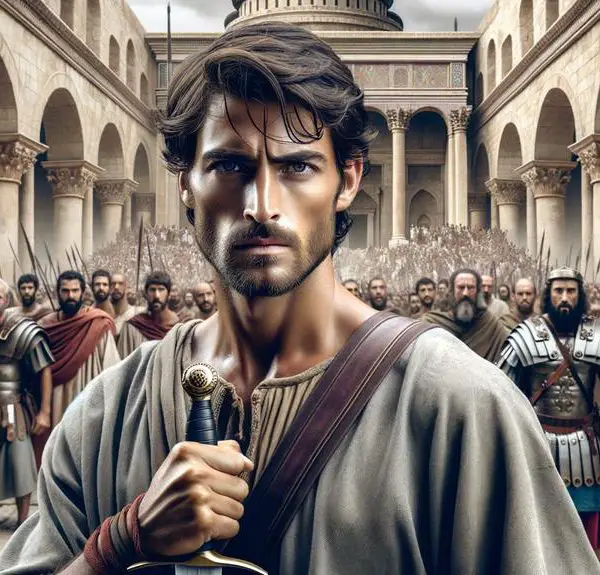

Sign up